Financial Performance Analysis of a Landscaping Business Report
VerifiedAdded on 2020/04/01
|6
|1470
|47
Report
AI Summary
This report presents a comprehensive financial analysis of a landscaping business. It begins with a cash budget analysis for three months, comparing scenarios of equipment purchase versus leasing, highlighting the impact on cash flow. The report then calculates break-even points for different product lines, considering various sales mixes and their effect on overall profitability. Furthermore, it delves into capital budgeting, emphasizing the importance of Net Present Value (NPV) and contrasting the limitations of Average Rate of Return (ARR) and Internal Rate of Return (IRR) in investment decisions. The analysis concludes with recommendations on optimizing sales mix to enhance profit, supported by detailed financial calculations and references to relevant financial management literature.
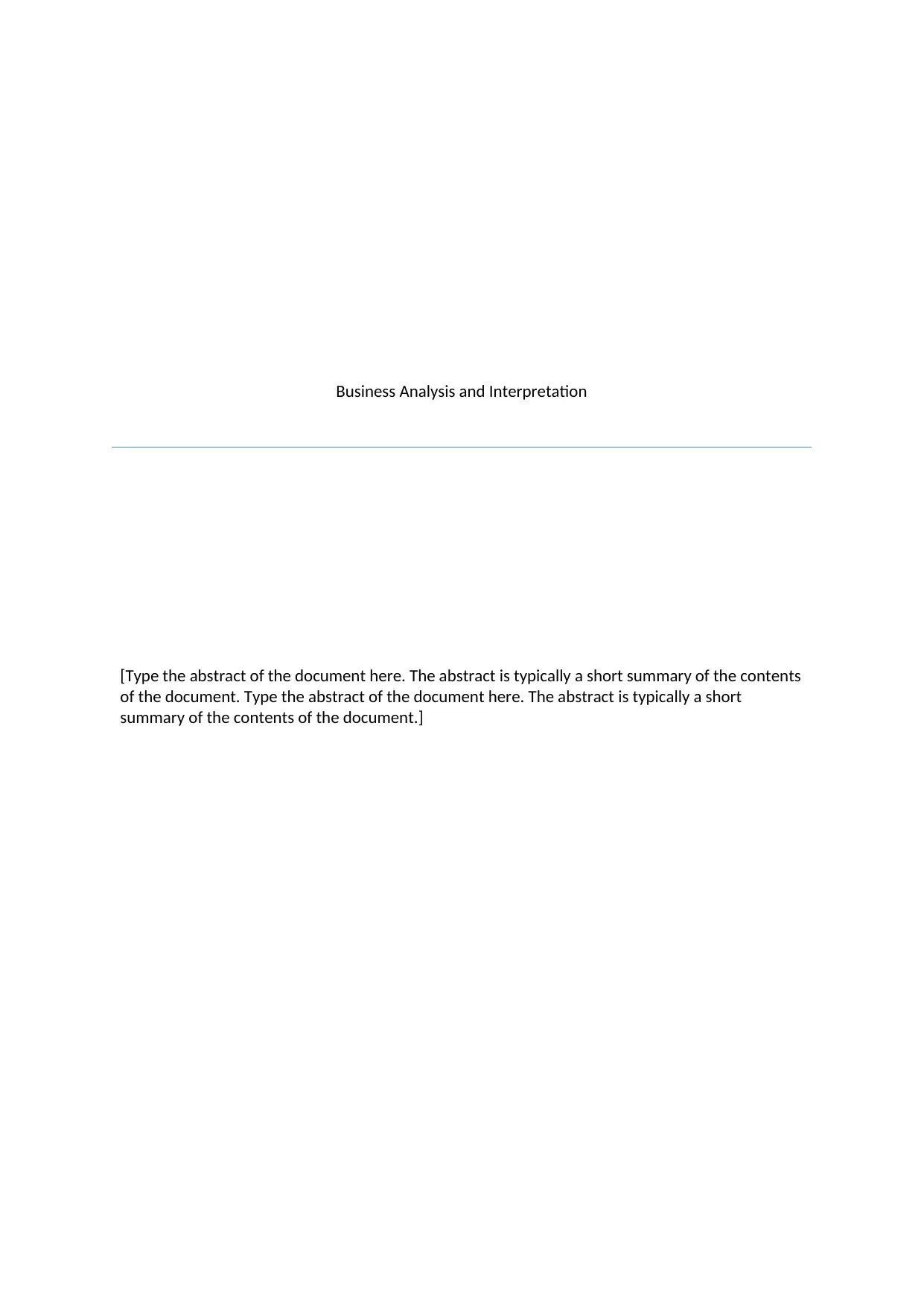
Business Analysis and Interpretation
[Type the abstract of the document here. The abstract is typically a short summary of the contents
of the document. Type the abstract of the document here. The abstract is typically a short
summary of the contents of the document.]
[Type the abstract of the document here. The abstract is typically a short summary of the contents
of the document. Type the abstract of the document here. The abstract is typically a short
summary of the contents of the document.]
Paraphrase This Document
Need a fresh take? Get an instant paraphrase of this document with our AI Paraphraser
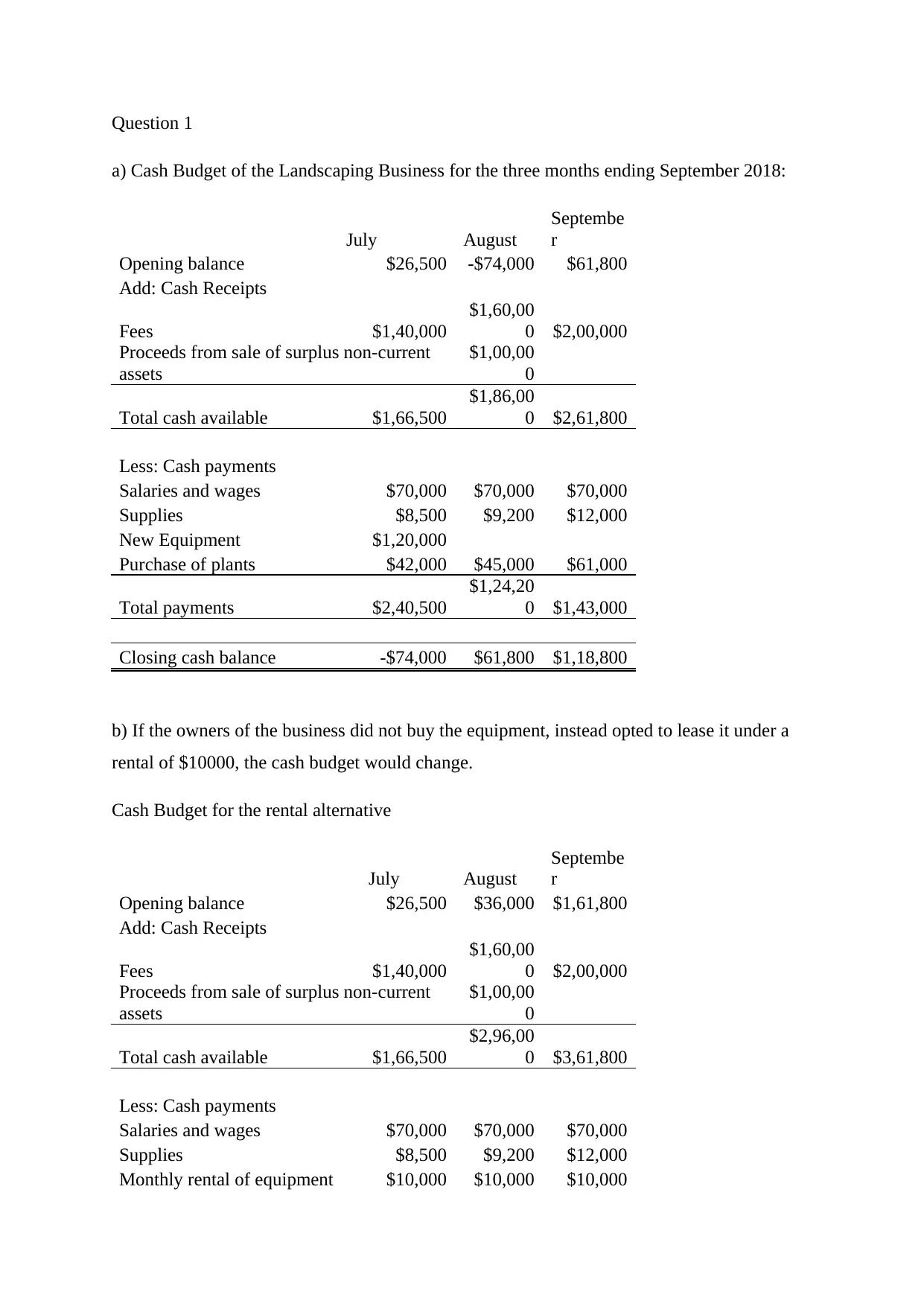
Question 1
a) Cash Budget of the Landscaping Business for the three months ending September 2018:
July August
Septembe
r
Opening balance $26,500 -$74,000 $61,800
Add: Cash Receipts
Fees $1,40,000
$1,60,00
0 $2,00,000
Proceeds from sale of surplus non-current
assets
$1,00,00
0
Total cash available $1,66,500
$1,86,00
0 $2,61,800
Less: Cash payments
Salaries and wages $70,000 $70,000 $70,000
Supplies $8,500 $9,200 $12,000
New Equipment $1,20,000
Purchase of plants $42,000 $45,000 $61,000
Total payments $2,40,500
$1,24,20
0 $1,43,000
Closing cash balance -$74,000 $61,800 $1,18,800
b) If the owners of the business did not buy the equipment, instead opted to lease it under a
rental of $10000, the cash budget would change.
Cash Budget for the rental alternative
July August
Septembe
r
Opening balance $26,500 $36,000 $1,61,800
Add: Cash Receipts
Fees $1,40,000
$1,60,00
0 $2,00,000
Proceeds from sale of surplus non-current
assets
$1,00,00
0
Total cash available $1,66,500
$2,96,00
0 $3,61,800
Less: Cash payments
Salaries and wages $70,000 $70,000 $70,000
Supplies $8,500 $9,200 $12,000
Monthly rental of equipment $10,000 $10,000 $10,000
a) Cash Budget of the Landscaping Business for the three months ending September 2018:
July August
Septembe
r
Opening balance $26,500 -$74,000 $61,800
Add: Cash Receipts
Fees $1,40,000
$1,60,00
0 $2,00,000
Proceeds from sale of surplus non-current
assets
$1,00,00
0
Total cash available $1,66,500
$1,86,00
0 $2,61,800
Less: Cash payments
Salaries and wages $70,000 $70,000 $70,000
Supplies $8,500 $9,200 $12,000
New Equipment $1,20,000
Purchase of plants $42,000 $45,000 $61,000
Total payments $2,40,500
$1,24,20
0 $1,43,000
Closing cash balance -$74,000 $61,800 $1,18,800
b) If the owners of the business did not buy the equipment, instead opted to lease it under a
rental of $10000, the cash budget would change.
Cash Budget for the rental alternative
July August
Septembe
r
Opening balance $26,500 $36,000 $1,61,800
Add: Cash Receipts
Fees $1,40,000
$1,60,00
0 $2,00,000
Proceeds from sale of surplus non-current
assets
$1,00,00
0
Total cash available $1,66,500
$2,96,00
0 $3,61,800
Less: Cash payments
Salaries and wages $70,000 $70,000 $70,000
Supplies $8,500 $9,200 $12,000
Monthly rental of equipment $10,000 $10,000 $10,000
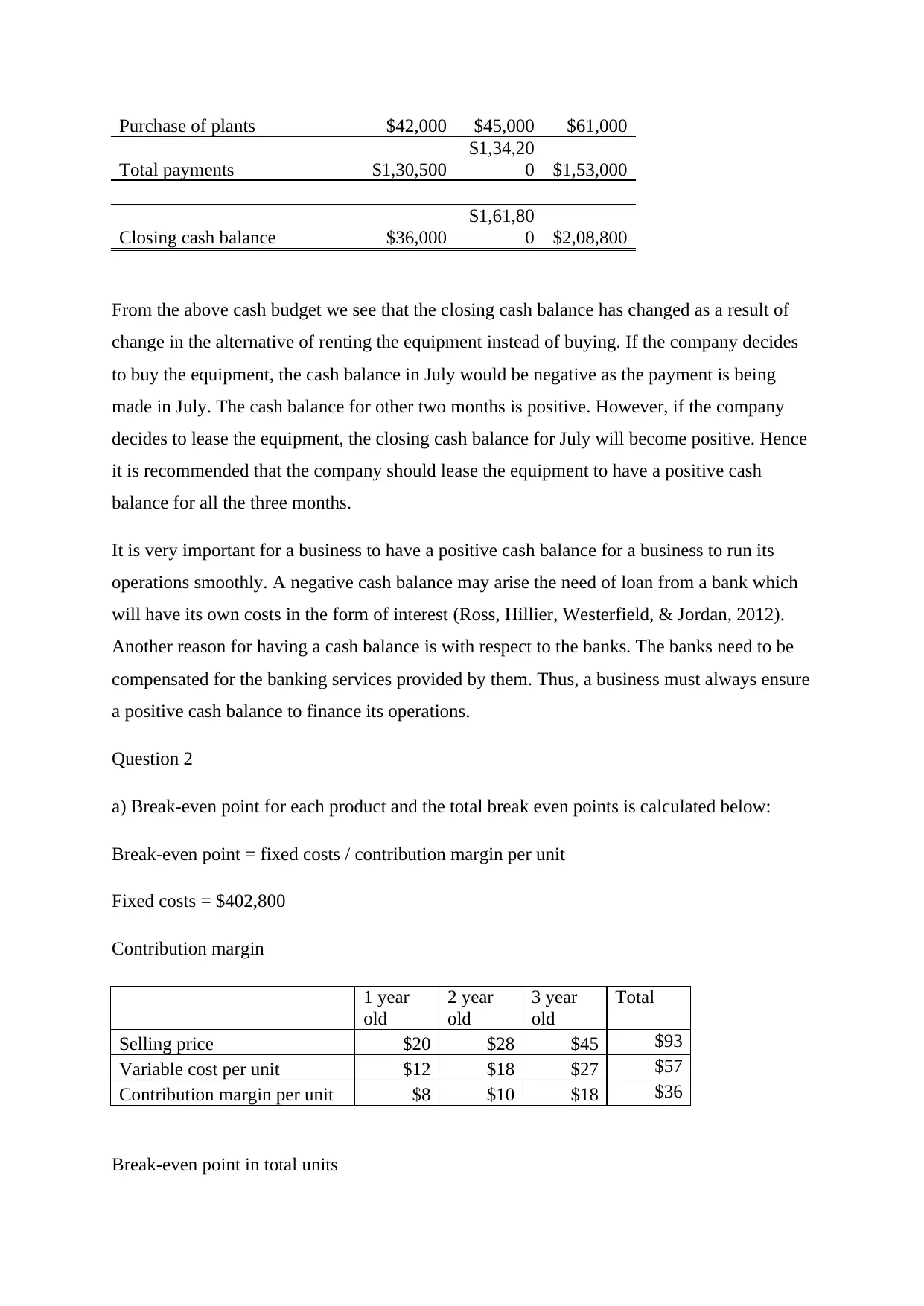
Purchase of plants $42,000 $45,000 $61,000
Total payments $1,30,500
$1,34,20
0 $1,53,000
Closing cash balance $36,000
$1,61,80
0 $2,08,800
From the above cash budget we see that the closing cash balance has changed as a result of
change in the alternative of renting the equipment instead of buying. If the company decides
to buy the equipment, the cash balance in July would be negative as the payment is being
made in July. The cash balance for other two months is positive. However, if the company
decides to lease the equipment, the closing cash balance for July will become positive. Hence
it is recommended that the company should lease the equipment to have a positive cash
balance for all the three months.
It is very important for a business to have a positive cash balance for a business to run its
operations smoothly. A negative cash balance may arise the need of loan from a bank which
will have its own costs in the form of interest (Ross, Hillier, Westerfield, & Jordan, 2012).
Another reason for having a cash balance is with respect to the banks. The banks need to be
compensated for the banking services provided by them. Thus, a business must always ensure
a positive cash balance to finance its operations.
Question 2
a) Break-even point for each product and the total break even points is calculated below:
Break-even point = fixed costs / contribution margin per unit
Fixed costs = $402,800
Contribution margin
1 year
old
2 year
old
3 year
old
Total
Selling price $20 $28 $45 $93
Variable cost per unit $12 $18 $27 $57
Contribution margin per unit $8 $10 $18 $36
Break-even point in total units
Total payments $1,30,500
$1,34,20
0 $1,53,000
Closing cash balance $36,000
$1,61,80
0 $2,08,800
From the above cash budget we see that the closing cash balance has changed as a result of
change in the alternative of renting the equipment instead of buying. If the company decides
to buy the equipment, the cash balance in July would be negative as the payment is being
made in July. The cash balance for other two months is positive. However, if the company
decides to lease the equipment, the closing cash balance for July will become positive. Hence
it is recommended that the company should lease the equipment to have a positive cash
balance for all the three months.
It is very important for a business to have a positive cash balance for a business to run its
operations smoothly. A negative cash balance may arise the need of loan from a bank which
will have its own costs in the form of interest (Ross, Hillier, Westerfield, & Jordan, 2012).
Another reason for having a cash balance is with respect to the banks. The banks need to be
compensated for the banking services provided by them. Thus, a business must always ensure
a positive cash balance to finance its operations.
Question 2
a) Break-even point for each product and the total break even points is calculated below:
Break-even point = fixed costs / contribution margin per unit
Fixed costs = $402,800
Contribution margin
1 year
old
2 year
old
3 year
old
Total
Selling price $20 $28 $45 $93
Variable cost per unit $12 $18 $27 $57
Contribution margin per unit $8 $10 $18 $36
Break-even point in total units
⊘ This is a preview!⊘
Do you want full access?
Subscribe today to unlock all pages.

Trusted by 1+ million students worldwide
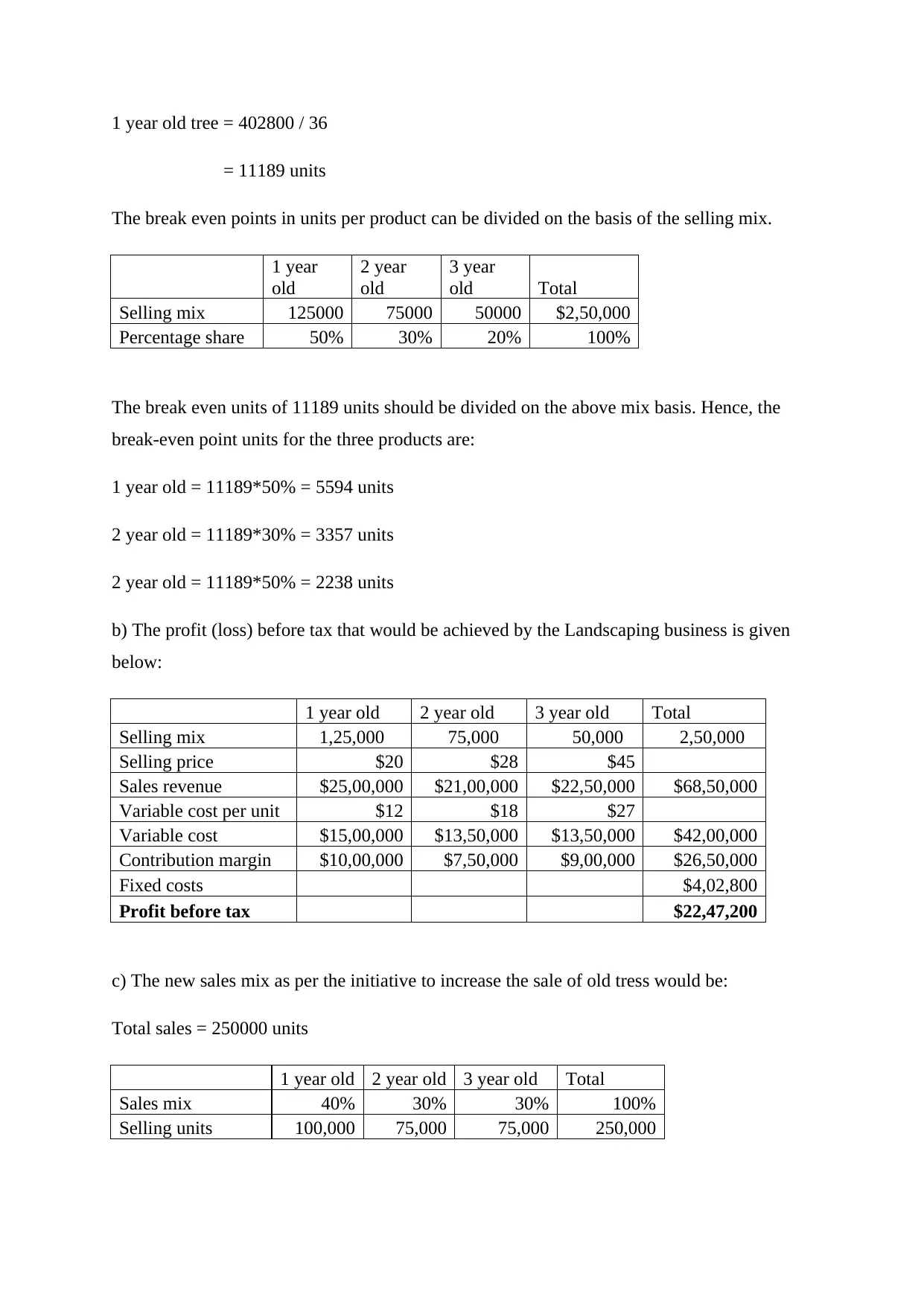
1 year old tree = 402800 / 36
= 11189 units
The break even points in units per product can be divided on the basis of the selling mix.
1 year
old
2 year
old
3 year
old Total
Selling mix 125000 75000 50000 $2,50,000
Percentage share 50% 30% 20% 100%
The break even units of 11189 units should be divided on the above mix basis. Hence, the
break-even point units for the three products are:
1 year old = 11189*50% = 5594 units
2 year old = 11189*30% = 3357 units
2 year old = 11189*50% = 2238 units
b) The profit (loss) before tax that would be achieved by the Landscaping business is given
below:
1 year old 2 year old 3 year old Total
Selling mix 1,25,000 75,000 50,000 2,50,000
Selling price $20 $28 $45
Sales revenue $25,00,000 $21,00,000 $22,50,000 $68,50,000
Variable cost per unit $12 $18 $27
Variable cost $15,00,000 $13,50,000 $13,50,000 $42,00,000
Contribution margin $10,00,000 $7,50,000 $9,00,000 $26,50,000
Fixed costs $4,02,800
Profit before tax $22,47,200
c) The new sales mix as per the initiative to increase the sale of old tress would be:
Total sales = 250000 units
1 year old 2 year old 3 year old Total
Sales mix 40% 30% 30% 100%
Selling units 100,000 75,000 75,000 250,000
= 11189 units
The break even points in units per product can be divided on the basis of the selling mix.
1 year
old
2 year
old
3 year
old Total
Selling mix 125000 75000 50000 $2,50,000
Percentage share 50% 30% 20% 100%
The break even units of 11189 units should be divided on the above mix basis. Hence, the
break-even point units for the three products are:
1 year old = 11189*50% = 5594 units
2 year old = 11189*30% = 3357 units
2 year old = 11189*50% = 2238 units
b) The profit (loss) before tax that would be achieved by the Landscaping business is given
below:
1 year old 2 year old 3 year old Total
Selling mix 1,25,000 75,000 50,000 2,50,000
Selling price $20 $28 $45
Sales revenue $25,00,000 $21,00,000 $22,50,000 $68,50,000
Variable cost per unit $12 $18 $27
Variable cost $15,00,000 $13,50,000 $13,50,000 $42,00,000
Contribution margin $10,00,000 $7,50,000 $9,00,000 $26,50,000
Fixed costs $4,02,800
Profit before tax $22,47,200
c) The new sales mix as per the initiative to increase the sale of old tress would be:
Total sales = 250000 units
1 year old 2 year old 3 year old Total
Sales mix 40% 30% 30% 100%
Selling units 100,000 75,000 75,000 250,000
Paraphrase This Document
Need a fresh take? Get an instant paraphrase of this document with our AI Paraphraser
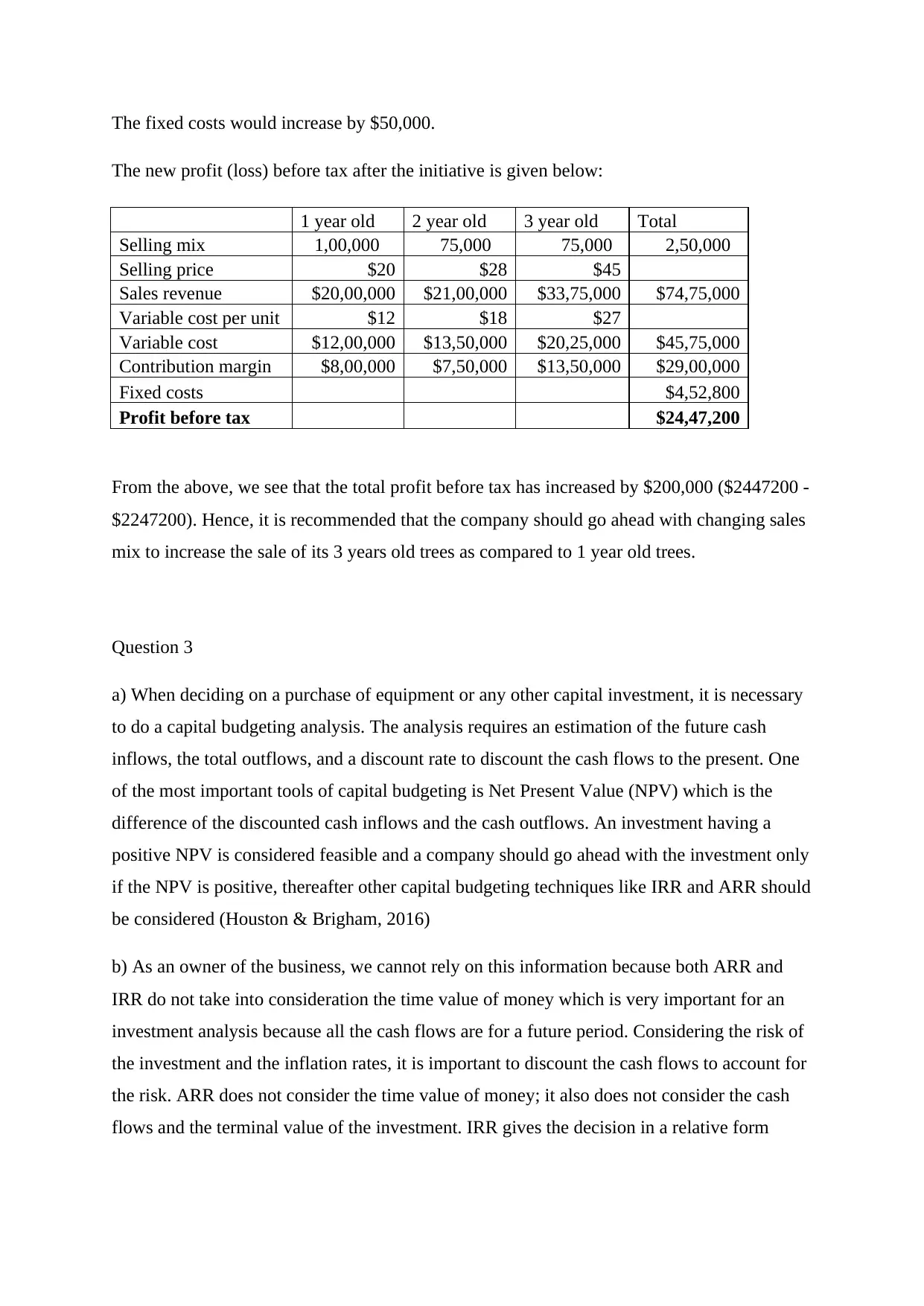
The fixed costs would increase by $50,000.
The new profit (loss) before tax after the initiative is given below:
1 year old 2 year old 3 year old Total
Selling mix 1,00,000 75,000 75,000 2,50,000
Selling price $20 $28 $45
Sales revenue $20,00,000 $21,00,000 $33,75,000 $74,75,000
Variable cost per unit $12 $18 $27
Variable cost $12,00,000 $13,50,000 $20,25,000 $45,75,000
Contribution margin $8,00,000 $7,50,000 $13,50,000 $29,00,000
Fixed costs $4,52,800
Profit before tax $24,47,200
From the above, we see that the total profit before tax has increased by $200,000 ($2447200 -
$2247200). Hence, it is recommended that the company should go ahead with changing sales
mix to increase the sale of its 3 years old trees as compared to 1 year old trees.
Question 3
a) When deciding on a purchase of equipment or any other capital investment, it is necessary
to do a capital budgeting analysis. The analysis requires an estimation of the future cash
inflows, the total outflows, and a discount rate to discount the cash flows to the present. One
of the most important tools of capital budgeting is Net Present Value (NPV) which is the
difference of the discounted cash inflows and the cash outflows. An investment having a
positive NPV is considered feasible and a company should go ahead with the investment only
if the NPV is positive, thereafter other capital budgeting techniques like IRR and ARR should
be considered (Houston & Brigham, 2016)
b) As an owner of the business, we cannot rely on this information because both ARR and
IRR do not take into consideration the time value of money which is very important for an
investment analysis because all the cash flows are for a future period. Considering the risk of
the investment and the inflation rates, it is important to discount the cash flows to account for
the risk. ARR does not consider the time value of money; it also does not consider the cash
flows and the terminal value of the investment. IRR gives the decision in a relative form
The new profit (loss) before tax after the initiative is given below:
1 year old 2 year old 3 year old Total
Selling mix 1,00,000 75,000 75,000 2,50,000
Selling price $20 $28 $45
Sales revenue $20,00,000 $21,00,000 $33,75,000 $74,75,000
Variable cost per unit $12 $18 $27
Variable cost $12,00,000 $13,50,000 $20,25,000 $45,75,000
Contribution margin $8,00,000 $7,50,000 $13,50,000 $29,00,000
Fixed costs $4,52,800
Profit before tax $24,47,200
From the above, we see that the total profit before tax has increased by $200,000 ($2447200 -
$2247200). Hence, it is recommended that the company should go ahead with changing sales
mix to increase the sale of its 3 years old trees as compared to 1 year old trees.
Question 3
a) When deciding on a purchase of equipment or any other capital investment, it is necessary
to do a capital budgeting analysis. The analysis requires an estimation of the future cash
inflows, the total outflows, and a discount rate to discount the cash flows to the present. One
of the most important tools of capital budgeting is Net Present Value (NPV) which is the
difference of the discounted cash inflows and the cash outflows. An investment having a
positive NPV is considered feasible and a company should go ahead with the investment only
if the NPV is positive, thereafter other capital budgeting techniques like IRR and ARR should
be considered (Houston & Brigham, 2016)
b) As an owner of the business, we cannot rely on this information because both ARR and
IRR do not take into consideration the time value of money which is very important for an
investment analysis because all the cash flows are for a future period. Considering the risk of
the investment and the inflation rates, it is important to discount the cash flows to account for
the risk. ARR does not consider the time value of money; it also does not consider the cash
flows and the terminal value of the investment. IRR gives the decision in a relative form
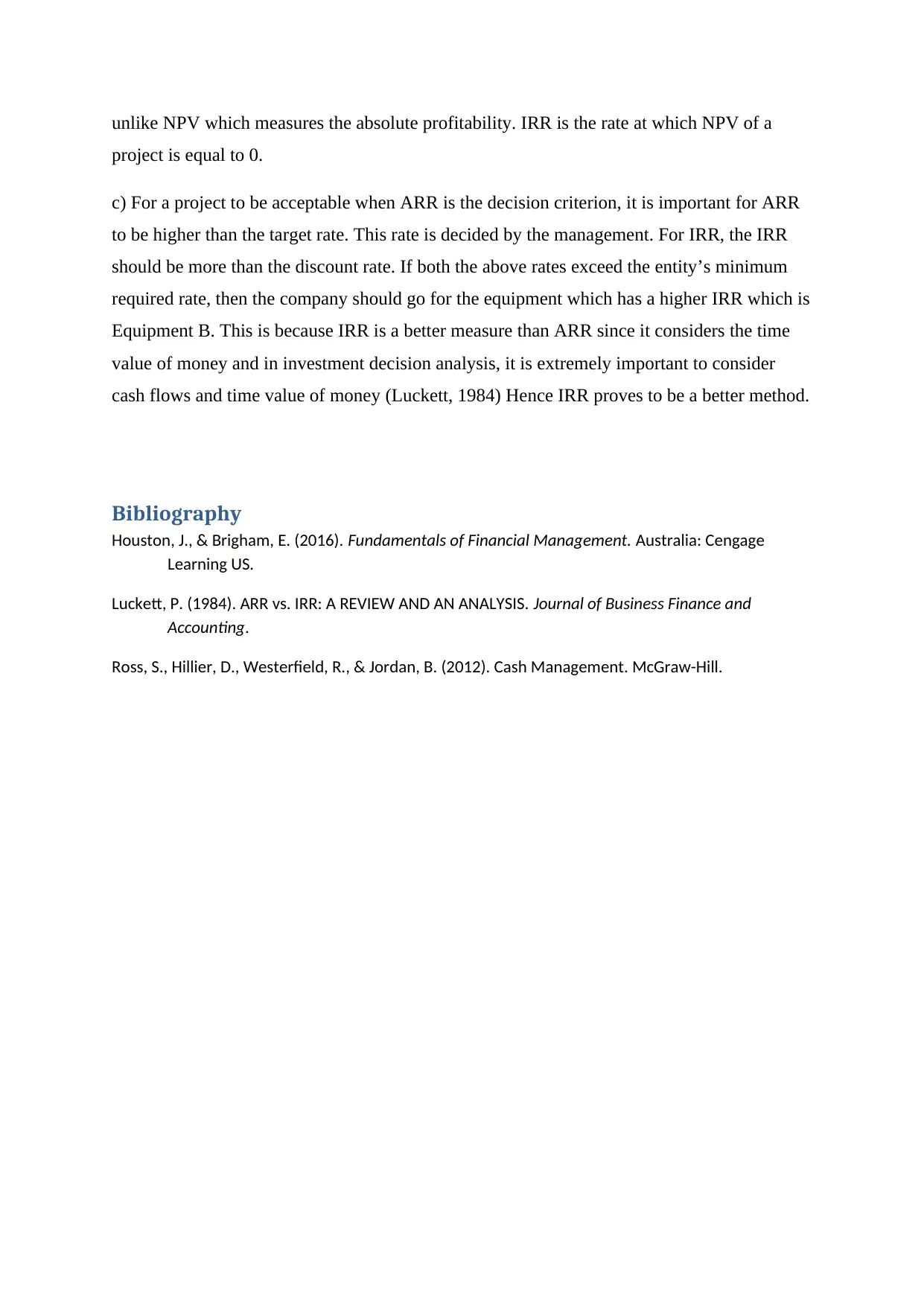
unlike NPV which measures the absolute profitability. IRR is the rate at which NPV of a
project is equal to 0.
c) For a project to be acceptable when ARR is the decision criterion, it is important for ARR
to be higher than the target rate. This rate is decided by the management. For IRR, the IRR
should be more than the discount rate. If both the above rates exceed the entity’s minimum
required rate, then the company should go for the equipment which has a higher IRR which is
Equipment B. This is because IRR is a better measure than ARR since it considers the time
value of money and in investment decision analysis, it is extremely important to consider
cash flows and time value of money (Luckett, 1984) Hence IRR proves to be a better method.
Bibliography
Houston, J., & Brigham, E. (2016). Fundamentals of Financial Management. Australia: Cengage
Learning US.
Luckett, P. (1984). ARR vs. IRR: A REVIEW AND AN ANALYSIS. Journal of Business Finance and
Accounting.
Ross, S., Hillier, D., Westerfield, R., & Jordan, B. (2012). Cash Management. McGraw-Hill.
project is equal to 0.
c) For a project to be acceptable when ARR is the decision criterion, it is important for ARR
to be higher than the target rate. This rate is decided by the management. For IRR, the IRR
should be more than the discount rate. If both the above rates exceed the entity’s minimum
required rate, then the company should go for the equipment which has a higher IRR which is
Equipment B. This is because IRR is a better measure than ARR since it considers the time
value of money and in investment decision analysis, it is extremely important to consider
cash flows and time value of money (Luckett, 1984) Hence IRR proves to be a better method.
Bibliography
Houston, J., & Brigham, E. (2016). Fundamentals of Financial Management. Australia: Cengage
Learning US.
Luckett, P. (1984). ARR vs. IRR: A REVIEW AND AN ANALYSIS. Journal of Business Finance and
Accounting.
Ross, S., Hillier, D., Westerfield, R., & Jordan, B. (2012). Cash Management. McGraw-Hill.
⊘ This is a preview!⊘
Do you want full access?
Subscribe today to unlock all pages.

Trusted by 1+ million students worldwide
1 out of 6
Your All-in-One AI-Powered Toolkit for Academic Success.
+13062052269
info@desklib.com
Available 24*7 on WhatsApp / Email
![[object Object]](/_next/static/media/star-bottom.7253800d.svg)
Unlock your academic potential
Copyright © 2020–2025 A2Z Services. All Rights Reserved. Developed and managed by ZUCOL.

